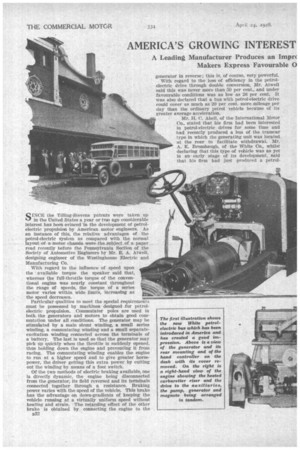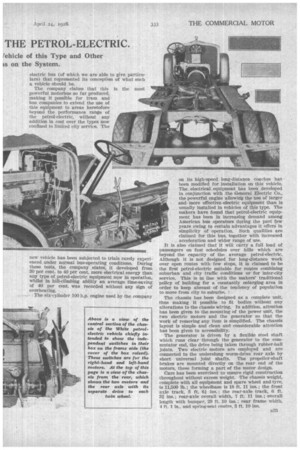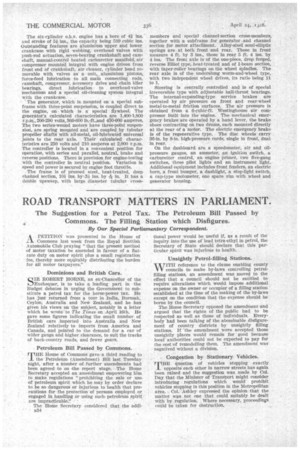AMERICA'S GROWING INTEREST THE PETROL-ELECTRIC.
Page 58

Page 59

Page 60

If you've noticed an error in this article please click here to report it so we can fix it.
A Leading Manufacturer Produces an Imprt Makers Express Favourable 0
rehicle of this Type and Other is on the System.
SINCE the Tilling-Stevens patents were taken up in the United States a year or two ago considerable interest has been evinced in the development of petrolelectric propulsion by American motor engineers. As an instance of this, the relative advantages of the petrol-electric system as compared with the normal layout of a motor chassis were the subject of a paper read recently before the Pennsylvania Section of the Society of Automotive Engineers by Mr. E. A. Atwell, designing engineer of the Westinghouse Electric and Manufacturing Co.
With regard to the influence of speed upon the available torque the speaker said that, whereas the full-throttle torque of the conventional engine was nearly constant throughout the range of speeds, the torque of a series motor varies within wide limits, increasing as the speed decreases.
Particular qualities to meet the special requirements must be possessed by machines designed for petrolelectric propulsion. Commutator poles are used in both the generators and motors to obtain good commutation under all conditions. The generator may be stimulated by a main shunt winding, a small series winding, a commutating winding and a small separateexcitation winding connected across the terminals of a battery. -The last is used so that the generator may pick up quickly when the throttle is suddenly opened, thus holding down the engine and preventing it from racing. The commutating winding enables the engine to run at a higher speed and to give greater horsepower, the driver getting this extra power by cutting out the winding by means of a foot switch.
Of the two methods of electric braking available, one is directly dynamic, the engine being disconnected from the generator, its field reversed and its terminals connected together through a resistance. Braking power varies with the speed of the vehicle. This brake has the advantage on down-gradients of keeping the vehicle running at a virtually uniform speed without heating and strain. The retarding effect of the other brake is obtained by connecting the engine to the
tub.
generator in reverse; this is, of course, very powerful.
With regard to the loss of efficiency in the petrolelectric drive through double conversion, Mr. Atwell said this was never more than 50 per cent., and under favourable conditions was as low as 26 per cent. It was also declared that a bus with petrol-electric drive could cover as much as 20 per cent. more mileage per day than the ordinary petrol vehicle because of its greater average acceleration.
Mr. H. C. Abell, of the International Motor Co., stated that his firm had been interested in petrol-electric drives for some time and had recently produced a bus of the tramcar type in which the generating unit was located at the rear to facilitate withdrawal. Mr. A. K. Brumbaugh, of the White Co., whilst declaring that this type of vehicle was as yet in an early stage of its development, said that his firm had just .produced a petrol electric bus (of which we are able to give particu lars) that represented its conception of what such a vehicle should be.
The company claims that this is the most powerful motorbus so far produced, making it possible for tram and bus companies to extend the use of this equipment to areas heretofore beyond the performance range of the petrol-electric, without any addition in cost over the types now confined to limited city service. The new vehicle has been subjected to trials rarely experienced under normal bus-operating conditions. During these tests, the company states, it developed from 30 per cent. to 40 per cent, more electrical energy than any type of petrol-electric equipment now in operation, whilst in hill-climbing ability an average time-saving of 40 per cent. Was recorded without any sign of overheating.
The six-cylinder 100 h.p. engine used by the company on its high-speed long-distance coaches has been modified for installation on this vehicle. The electrical equipment has been developed in conjunction with the General Electric Co., the powerful engine allowing the use of larger and more effective electric equipment than is usually installed in vehicles of this type. The makers have found that petrol-electric equipment has been in increasing demand among American bus operators during the past few years owing to certain advantages it offers in simplicity of operation. Such qualities are claimed for this bus, together with increased acceleration and wider range of use.
It is also claimed that it will carry a full load of passengers on fast schedules over hills which are beyond the capacity of the average petrol-electric. Although it is not designed for long-distance work over open routes with few stops, it is claimed to be the first petrol-electric suitable for routes combining suburban and city traffic conditions or for inter-city service. This is in line with the makers' traditional policy of building for a constantly enlarging area in order to keep abreast of the tendency of population to move from city to suburbs.
The chassis has been designed as a complete unit, thus making it possible to fit bodies without any alterations to the chassis wiring. In addition, attention has been given to the mounting of the power unit, the two electric motors and the generator so that the work of removing any item is simplified. The chassis layout is simple and clean and considerable attention has been given to accessibility.
The generator is driven by a flexible steel shaft which runs clear through the generator to the commutator end, the drive being taken through rubber-ball
joints.electric motors arc employed and are connectd to the undershing worm-drive rear axle by short universal joint shafts. The propeller-shaft brakes are mounted directly on the rear end of the motors, these forming a part of the motor design.
Care has been exercised to ensure rigid construction throughout without excess weight. The chassis weight, complete with all equipment and spare wheel and tyre, is 11,500 lb. ; the wheelbase is 18 ft. 11 ins.; the front axle track, 5 ft. 61 ins. ; the rear-axle track, 6 ft.
34 ins. ; rear-axle overall width, 7 ft. n ; overall length with bumper, 29 ft. 10 ins. ; rear frame width, ft. 1 In., and spring-seat centre, 3 ft. 10 ins.
The six-cylinder o.h.v. engine has a bore of 4i ins. and stroke of 5i ins., the capacity being 519 cubic ins. Outstanding features are aluminium upper and lower crankcase with rigid webbing, overhead valves with push-rod actuation, seven-bearing crankshaft and camshaft, manual-control heated carburetter manifold, air compressor mounted integral with engine driven from front end of crankshaft, air cleaner, cylinder head removable with valves as a unit,. aluminium pistons, force-feed lubrication to all main connecting rods, camshaft, compressor, accessory drive and chain idler bearings, direct lubrication to overhead-valve mechanism and a special oil-cleaning system integral with the crankcase.
" The generator, which is mounted on a special subframe with three-point suspension, is coupled direct to the engine, onwhich is a special flywheel. The generator's calculated characteristics are 1,400-1,800 r.p.rm, 200-290 volts, 360-600 lb.-ft.,and 450-600 amperes. The two series-wound motors have three-point suspension, are spring mounted and are coupled by tubular propeller shafts with all-metal, oil-lubricated universal Joints to the rear axle. Their calculated characteristics are 250 volts and 210 amperes at 2,000 r.p.m. The controller is located in a convenient position for operation, with series and parallel, neutral, brake and reverse positions. There is provision for engine-testing with the controller in neutral position. Variation in speed and power is secured by engine foot throttle.
• The frame is of pressed steel,, heat-treated, deep
channel section, 10-k ins. by'Si. ins. by 1-56in. It has a double upsweep, with large diameter tubular cross
members and special channel-section cross-members, together with a subframe for generator and channel section for motor attachment. Alloy-steel semi-elliptic springs are at both front and rear. Those in front measure 4 ft. by 3 ins., those in rear 5 ft. 4 ins. by 4 ins. The front axle is of the one-piece, drop forged, reverse Elliot type, heat-treated and of I-beam section, with taper-roller bearings on the wheel spindles. The rear axle is of the underslung worm-and-wheel type, with two independent wheel drives, its ratio being 11 to 1.
Steering is centrally controlled and is of special irreversible type with adjustable ball-thrust bearings. The internal-expanding-type service brakes are operated by air pressure on front and rear-wheel metal-to-metal friction surfaces. The air pressure is obtained from a 6-cubic-ft. Westinghouse air compressor built • into the engine. The mechanical emergency brakes are operated by a hand lever, the brake shoes contracting on two drums, each mounted directly at the rear of a motor. The electric emergency brake is of the regenerative type. The disc wheels carry 36-in, by 8-in, high-pressure cords, single in front, dual in rear.
On the dashboard are a speedometer, air and oilpressure gauges, an ammeter, an ignition switch, a carburetter control, an engine primer, two five-gang switches, three pilot lights and an instrument light. Additional equipment includes front fenders, an electric horn, a front bumper, a dashlight, a stop-light switch, a cap-type motometer, one spare rim with wheel and generator housing.




















































































































